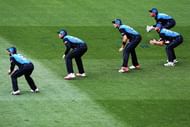
Cricket, and particularly limited-overs cricket, has gone through a plethora of changes in rules over the past few decades in order to ensure that the game is an attractive one for spectators.
Some of those rule changes have added immense value to the game while others haven’t quite passed muster, but there is that small matter of a handful of positive rule changes that have been scrapped by the ICC.
Here we look at those changes that should never have been scrapped.
#5 The Super Sub
Back in 2005, the ICC had become a bit anxious about the overall popularity of cricket as a game and hence decided to reorganise the game with a few nifty changes to the rules in ODIs. One of them, the super sub, appeared to be a straight lift from football and allowed teams to name a 12th player, who could then be drafted into the game at some point by replacing someone in the first eleven.
The rule did not gain much support from captains and was eventually scrapped, however, it presents an interesting angle for spectators. For instance, in this day and age of super sized bats and fast outfields, captains would invariably have gone in one batsman short in most games.
It presented a strategic conundrum that captains could not cope with 12 years ago but the rule in principle was a good one. Maybe it was ahead of its time.
#4 Mandatory catchers

This might be a bit of a controversial one yet there is an argument that the idea to have mandatory catchers within 15 yards during the power plays wasn't a bad one after all. The decision to scrap the rule was based on the fact that the game was getting too lopsided in favour of the batsmen and hence fielding captains needed a bit of flexibility as regards their field placements.
That said, more often than not, captains still start games with two or more catchers during the initial powerplay overs and the scrapping of the rule seems redundant in retrospect. In addition to that, it also kept the batsmen honest and ensured that even if they could take liberties in limited-overs cricket, those two fielders were always there to pounce on any mistakes.
#3 Discontinuing the use of the runner

When the laws of cricket were first introduced in 1744, there was no mention of a runner but it was included at some point in the last 120 years and became a well-known aspect of the game. However, in 2011, the ICC outlawed the use of runners completely, stating that if a batsman was not able to run, then he must retire hurt.
While it is true that the rule might have been misused from time to time by some batsmen, there is no doubt that the option of using the runner should not have been scrapped. It exposes a batsman to the danger of running despite suffering injuries and needless to say, it can lead to damaging consequences.
If a batsman is set and in sight of victory, then he would most likely force himself to play on despite his inability to run, which is why this rule poses a danger.
#4 Scrapping the batting powerplay

When the ICC first introduced the batting powerplay it gave the batting team another stick to beat the bowling team with, but at the same time, it introduced another strategic consideration for the batting side.
As a result, it became quite a hit with the cricket-watching public since there was an element of excitement about the timing of the batting powerplay. However, the scrapping of the rule has taken that element out of the game now and the ICC’s insistence that they scrapped it in order to make the game simpler for the spectators, is a bit insulting for cricket fans, who are well-versed with the rules of the game.
#1 Diluting the umpire's call in DRS

The Umpire Decision Review System is possibly one of the most progressive steps that the ICC has ever taken and while it might be argued that it took away some of the power from the umpire, it ensured that wrong decisions could be overturned.
In this regard, the umpire's call was an excellent rule by way of which the on-field decision held a degree of importance. However, last year, the umpire's call rule was largely diluted by the ICC. Earlier, more than 50% of the ball had to be hitting the stumps for an on-field decision to be overturned in case of LBWs, however, the new rule has changed the zone from outside of the leg stump to outside of the off stump.
This will lead to more decisions getting overturned and in a nutshell, the power of the umpire has been diluted a fair bit.
Follow IPL Auction 2025 Live Updates, News & Biddings at Sportskeeda. Get the fastest updates on Mega-Auction and cricket news
